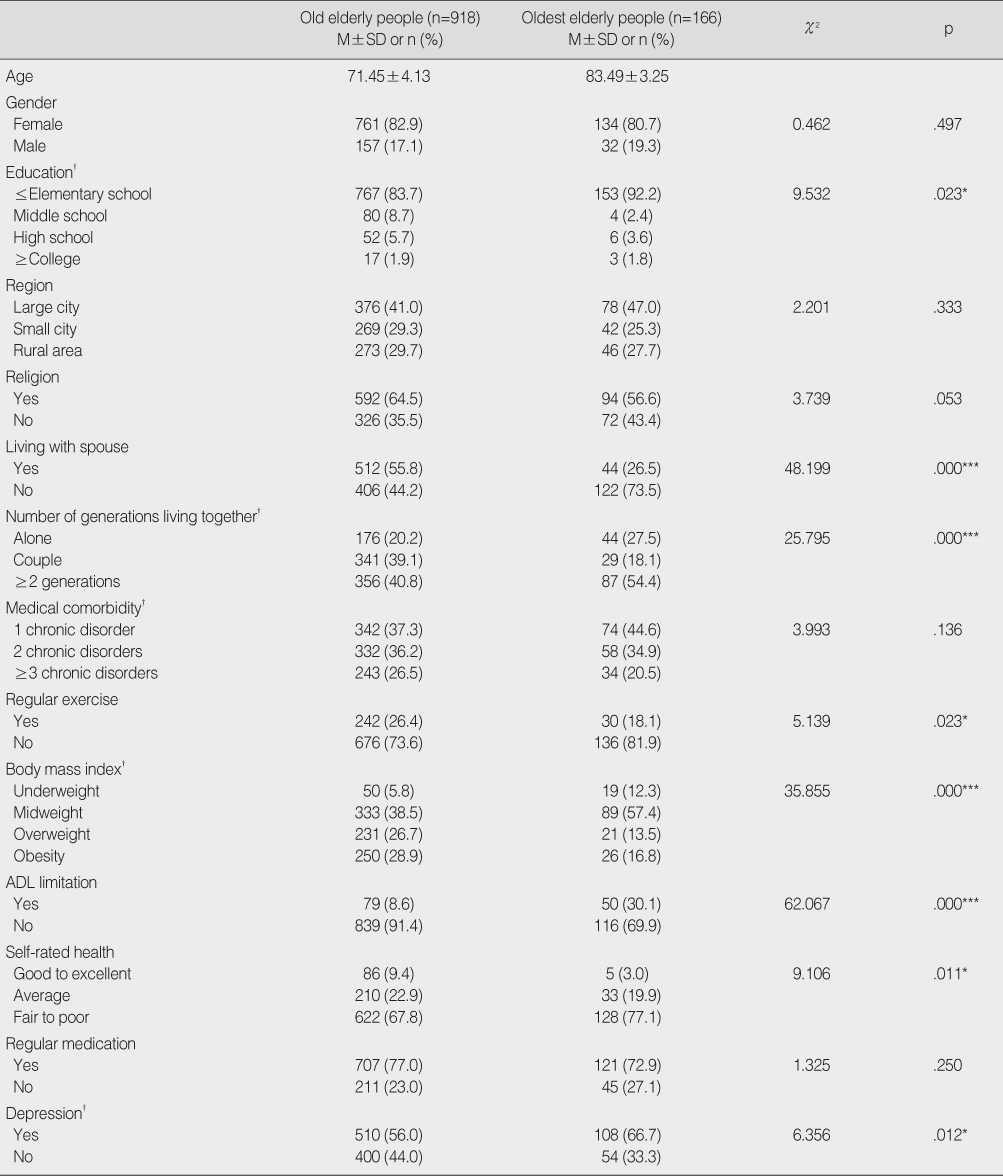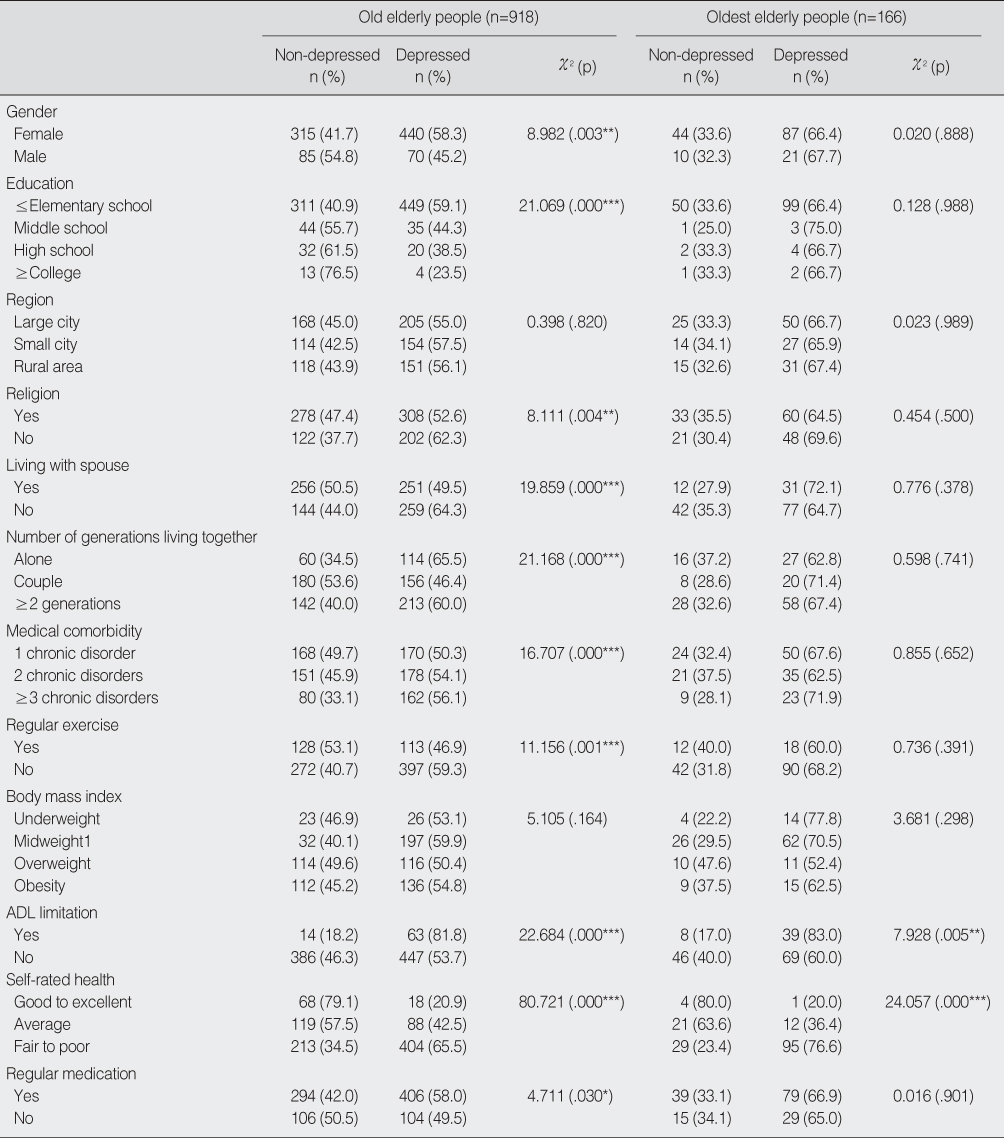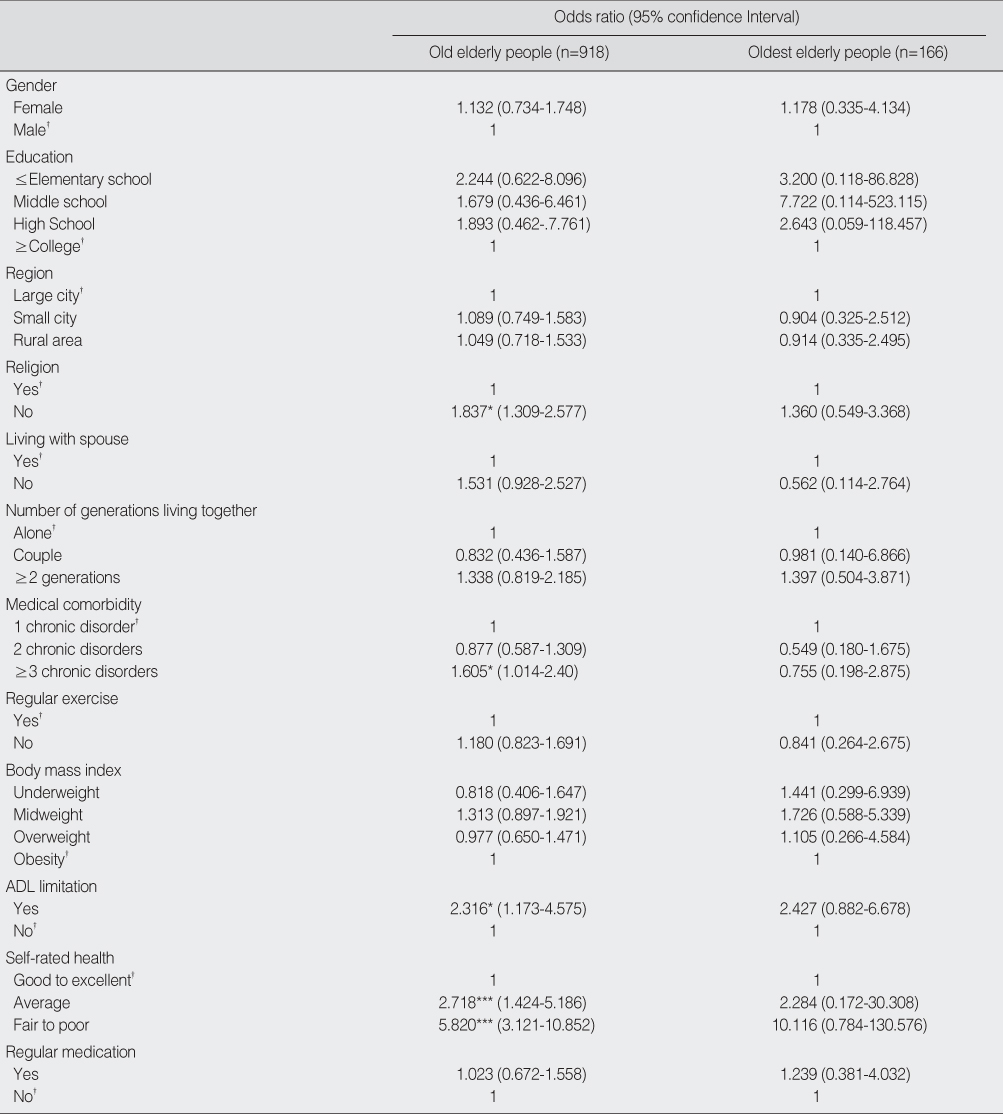Articles
- Page Path
- HOME > J Korean Acad Nurs > Volume 39(1); 2009 > Article
-
Original Article
- Depressive Symptoms and Related Risk Factors in Old and Oldest-old Elderly People with Arthritis
- Ji-Yeon An, Young-Ran Tak
-
Journal of Korean Academy of Nursing 2009;39(1):72-83.
DOI: https://doi.org/10.4040/jkan.2009.39.1.72
Published online: February 28, 2009
1Part-time Lecturer, Department of Nursing, Hanyang University, Seoul, Korea.
2Professor, Department of Nursing, Hanyang University, Seoul, Korea.
- Address reprint requests to: An, Ji-Yeon. Department of Nursing, Hanyang University, 17 Haengdang-dong, Seongdong-gu, Seoul 133-791, Korea. Tel: 82-2-2220-0700, Fax: 82-2-2295-2074, anjiyeon75@hanmail.net
Copyright © 2009 Korean Society of Nursing Science
Abstract
-
Purpose
- This study was to investigate the prevalence of depressive symptoms and risk factors in elderly people (old vs oldest-old) with arthritis.
-
Methods
- The Korean Longitudinal Study of Aging (KLoSA) was used with a sample of 1,084 elderly people with arthritis aged 65 or above.
-
Results
- We found that the prevalence of depressive symptom was greater for oldest-old people (66.7%) compared to old people (56%). Significant differences between old people and oldest-old people were found for education, living with spouse, number of generation, regular exercise, body mass index (BMI), ADL limitation, self-rated health, and depression. Significant differences existed between depression and non-depression in terms of all variables except region and BMI among old people. But, among the oldest people, ADL limitation and self-rated health showed differences. The Logistic regression analysis revealed that religion, medical comorbidity, ADL limitation, self-rated health were significantly associated with depressive symptoms in old people. But, in oldest-old people, none of the variables were associated with depressive symptoms.
-
Conclusion
- The findings show that there are age differences in depression and related factors in elderly people with arthritis. Longitudinal studies, which covered depressive symptom severity and which are controlled for a large number of potential confounders, will need to complement the results of this study in the future.
- 1. Blazer DG. Psychiatry and the oldest old. The American Journal of Psychiatry. 2000;157:1915–1924.ArticlePubMed
- 2. Bonin-Guillaume S, Hasbroucq T, Blin O. Psychomotor retardation associated to depression differs from that of normal aging. Psychologie & Neuropsychiatrie du Vieillissement. 2008;6:137–144.
- 3. Bruce TO. Comorbid depression in rheumatoid arthritis: Pathophysiology and clinical implications. Current Psychiatry Reports. 2008;10:258–264.ArticlePubMedPDF
- 4. Choi NG, Kim JS. Age group differences in depressive symptoms among older adults with functional impairments. Health & Social Work. 2007;32:177–188.Article
- 5. Chou KL, Chi I. Prevalence and correlates of depression in Chinese oldest-old. International Journal of Geriatric Psychiatry. 2005;20:41–50.ArticlePubMed
- 6. Chu SK, Yoo JH, Lee CY. The effects of a cognitive behavior program on cognition, depression, and activities of daily living in elderly with cognitive impairment. Journal of Korean Academy of Nursing. 2007;37:1049–1060.ArticlePubMedPDF
- 7. Gazmararian J, Baker D, Parker R, Blazer DG. A multivariate analysis of factors associated with depression: Evaluating the role of health literacy as a potential contributor. Archives of Internal Medicine. 2000;160:3307–3314.PubMed
- 8. Irwin M, Artin KH, Oxman MN. Screening for depression in the older adult: Criterion validity of the 10-item Center for Epidemiological Studies Depression Scale (CES-D). Archives of Internal Medicine. 1999;159:1701–1704.PubMed
- 9. Kang IO, Yun YH. Preliminary investigation of the quality of life in the elderly with cancer. Journal of Korean Academy of Family Medicine. 2004;25:678–686.
- 10. Ki BS, Choi IG, Han JH. Depression in older patients. Biological Research Information Center BioWave. 2004;6:1–17.
- 11. Kim KB, Yun JH, Sok SR. Effects of Individual Reminiscence Therapy on Older Adults' Depression, Morale and Quality of Life. Journal of Korean Academy of Nursing. 2006;36:813–820.ArticlePubMedPDF
- 12. Kim SY, Won CW, Rho YG. The validity and reliability of Korean version of Barthel ADL Index. Journal of Korean Academy of Family Medicine. 2004;25:534–541.
- 13. Kivinen P, Halonen P, Eronen M, Nissinen A. Self-rated health, physician-rated health and associated factors among elderly men: The Finnish cohorts of the seven countries studies. Age and Ageing. 1998;27:41–47.PubMed
- 14. Korean longitudinal study of aging. Korea Labor Institute. 2008;09;Retrieved September 23, 2008. from http://klosa.kli.re.kr.
- 15. Population projections for Korea: 2005-2050 based on the 2005 census. Korea National Statistical Office. 2006;05;Retrieved September 4, 2008. from http://www.kosis.kr/search/totalSearch2.jsp.
- 16. McDougall FA, Matthews FE, Kvaal K, Dewey ME, Brayne C. Prevalence and symptomatology of depression older people living in institutions in England and Wales. Age and Aging. 2007;36:562–568.
- 17. Mills TL. Comorbid depressive symptomatology: Isolating the effects of chronic medical conditions on self-reported depressive symptoms among community-dwelling older adults. Social Science & Medicine. 2001;53:569–578.
- 18. Nakajima A, Kamitsuji S, Saito A, Tanaka E, Nishimura K, Horikawa N, et al. Disability and patient's appraisal of general health contribute to depressed mood in rheumatoid arthritis in a large clinical study in Japan. Modern rheumatology. 2006;16:151–157.ArticlePubMed
- 19. Niti M, Ng TP, Kua EH, Ho RC, Tan CH. Depression and chronic medical illnesses in Asian older adults: The role of subjective health and functional status. International Journal of Geriatric Psychiatry. 2007;22:1087–1094.ArticlePubMed
- 20. Penninx BW, Beekman AT, Deeg DJ, Van Tilburg W. Effects of depression on physical health and mortality in the elderly. Longitudinal results of the LASA research. Tijdschrift voor Gerontologie en Geriatrie. 2000;31:211–218.PubMed
- 21. Penninx BW, Beekman AT, Ormel J, Kriegsman DM, Boeke AJ, Van Eijk J, et al. Psychological status among elderly people with chronic diseases: Does type of disease play a part? Journal of Psychosomatic Research. 1996;40:521–534.ArticlePubMed
- 22. Radloff LS. Anonymous applied psychological measurement: The CES-D Scale: A self-report depression scale for research in the general population. 1977;New York, NY, West Publishing.
- 23. Rapp MA, Gerstorf D, Helmchen H, Smith J. Depression predicts mortality in the young old, but not in the oldest old: Results from the Berlin Aging Study. The American Journal of Geriatric Psychiatry. 2008;16:844–852.ArticlePubMed
- 24. Rivard V, Cappeliez P. Perceived control and coping in woman faced with activity restriction due to osteoarthritis: Relations to anxious and depressive symptoms. Canadian Journal on Aging. 2007;26:241–253.PubMed
- 25. Seo NS, Chung YH, Kim JS. Factors related to quality of life among rural elderly. Journal of Korean Academy of Adult Nursing. 2005;17:379–388.
- 26. Stek ML, Gussekloo J, Beekman AT, Van Tilburg W, Westendorp RG. Prevalence, correlates and recognition of depression in the oldest old: The Leidon 85-plus study. Journal of Affective Disorders. 2004;78:193–200.ArticlePubMed
- 27. Stek ML, Vinkers DJ, Gussekloo J, Van Der Mast RC, Beekman AT, Westendorp RJ. Natural history of depression in the oldest old: Population-based prospective study. The British Journal of Psychiatry. 2006;188:65–69.PubMed
- 28. Sung KW, Kim MH. Self-care behaviors and depressive symptoms of low-income elderly woman with hypertension. Journal of Korean Academy of Nursing. 2008;38:593–602.
- 29. World population prospects: the 2006 revision. United Nations, New York. 2007;03;Retrieved October 6, 2008. from http://www.un.org/esa/population/publications/wpp2006/wpp2006.htm.
- 30. Weyerer S, Eifflaender-Gorfer S, Kohler L, Jeesen F, Maier W, Fuchs A, et al. Prevalence and risk factors for depression in non-demented primary care attenders aged 75 years and older. Journal of Affective Disorders. 2008;111:153–163.ArticlePubMed
REFERENCES
Figure & Data
REFERENCES
Citations

- Risk Factors for Depressive Symptoms among Older Adults with Mild Cognitive Impairment: An Analysis of Data from the Eighth Korean Longitudinal Study of Aging 2020
Mijung Cho
Journal of Korean Academy of Fundamentals of Nursing.2023; 30(2): 236. CrossRef - Association between depressive mood and chronic periodontitis among senior residents using the National Health Insurance Service‐Senior Cohort Database
Yu‐Rin Kim, Minkook Son, Seoul‐Hee Nam
Journal of Periodontology.2023; 94(6): 742. CrossRef - Subjective age, depressive symptoms, and cognitive functioning across five domains
Emily P. Morris, Afsara B. Zaheed, Neika Sharifian, Ketlyne Sol, A. Zarina Kraal, Laura B. Zahodne
Journal of Clinical and Experimental Neuropsychology.2021; 43(3): 310. CrossRef - The Effects of Subjective Health Status and Loneliness on Depression among Older Adults:Focusing on Moderated Mediation Effects of Age-friendly Environments
김수린, CHUNGSOONDOOL, kim ju-hyun
Korean Journal of Gerontological Social Welfare.2018; 73(2): 9. CrossRef - Depression and Perceived Quality of Sleep in Older Adults with Knee Osteoarthritis
Shin Hye Park, Jeong Soo Kim
Journal of Korean Gerontological Nursing.2017; 19(2): 145. CrossRef - Effects of Korean medicine based arthritis management program on joint function, physical fitness and self care of the elderly women with osteoarthritis.
김영희, Jeong, Heon-Young, 박금숙
Society of Preventive Korean Medicine.2017; 21(2): 105. CrossRef - A Study on IADL, Stress and Motivation on Healthy Lifestyle among Elderly People with Arthritis
Jong Gun Kim, Kyeung Hee Moon, Eun Sun Lim, Jang Hak Yoo
Journal of the Korea Academia-Industrial cooperation Society.2016; 17(3): 209. CrossRef - Health Perception and Family Support as Influencing Factors on Depression in Hospitalized Elderly Patients
Sun-Ok Lee, Moon-Jeong Kim
The Korean Journal of Health Service Management.2015; 9(4): 145. CrossRef - Physical disability, perceived dependence and depression in women with osteoarthritis
Ki-Soo Park, Hyeon-Su Yang, Bokyoung Kim, Hye-Ji Jeon
Journal of agricultural medicine and community health.2015; 40(4): 221. CrossRef - Health behaviors of the elderly with osteoarthritis across gender groups
Eunyoung Jeon
Journal of the Korean Data and Information Science Society.2015; 26(6): 1453. CrossRef - Sleep Quality and Factors affecting Sleep Disturbance among Percutaneous Coronary Angiography Patients in a General Hospital
Journal of East-West Nursing Research.2015; 21(1): 69. CrossRef - Social Network Changes of pre- and post- Retirement
Hyunchun Park, Jin Hyuk Hong, Minjae Choi, Young Dae Kwon, Jinseok Kim, Jin-Won Noh
The Journal of the Korea Contents Association.2014; 14(12): 753. CrossRef - The factors affecting psychological well-being of the oldest old elderly living alone in rural area
Seo, Honglan, HeeNyon Kim
Korean Journal of Gerontological Social Welfare.2014; null(64): 137. CrossRef - Risk Factors Influencing Depression among Elderly with Arthritis in Korean
Hye-Ryoung Kim, Hyun-Hee Im
The Korean Journal of Health Service Management.2014; 8(1): 103. CrossRef - Comparison of Prevalence for Osteoarthritis and Its Risk Factors between Age 60-74 and 75 and Over
Hye-Ryoung Kim
Journal of Korean Biological Nursing Science.2013; 15(4): 219. CrossRef - A Meta Analysis on Variables Related to Suppression of Depression of In-Home Elderly
권현숙
Korean Journal of Gerontological Social Welfare.2013; null(61): 241. CrossRef - Prevalence and Its Influencing Factors on Depression among Elderly Vulnerable People in Urban Community
Hye-Ryoung Kim
The Korean Journal of Health Service Management.2013; 7(3): 275. CrossRef - Prevalence of Depression and its Risk Factors among Aged at Social Service Centers in One Urban Community
Hye-Ryoung Kim
The Korean Journal of Rehabilitation Nursing.2013; 16(2): 79. CrossRef - Effects of Community-Dwelling Older Adults’Demographics and Social, Mental, and Physical Functions on Depressive Disorder
Dongjin Lee, Taesung Ko, Shangwhan Han
Journal of Physical Therapy Science.2013; 25(4): 463. CrossRef - Analysis of the Characteristics of the Older Adults with Depression Using Data Mining Decision Tree Analysis
Myonghwa Park, Sora Choi, A Mi Shin, Chul Hoi Koo
Journal of Korean Academy of Nursing.2013; 43(1): 1. CrossRef - Prevalence of Osteoarthritis and Its Affecting Factors among a Korean Population Aged 50 and Over
Hye-Ryoung Kim, Eun-Jung Kim
Journal of Korean Public Health Nursing.2013; 27(1): 27. CrossRef - Nutritional Risk, Perceived Health Status, and Depression of the Young-Old and the Old-Old in Low-Income Elderly Women
Myung-Suk Lee
Journal of agricultural medicine and community health.2012; 37(1): 12. CrossRef - Functional impairment but not metabolic syndrome is associated with depression in older Taiwanese: Results from the social environment and biomarkers of Aging study
A.C. Tsai, Hsin-Jen Tsai
The Journal of nutrition, health and aging.2012; 16(5): 492. CrossRef - Prevalence and Correlates of Depression in Older Koreans: Comparison of Young-old and Old-old
Kyung-Choon Lim, Seonho Kim
Journal of Korean Academy of Psychiatric and Mental Health Nursing.2012; 21(1): 1. CrossRef - The Effects of a Case Management Program of Customized Home Visiting Health Service for Clients with Arthritis
Soon-Ok Yang, Myung Soon Kwon, Yong-Jun Choi, Seung-Hee Lee
Journal of Korean Academy of Community Health Nursing.2011; 22(2): 151. CrossRef - Effects of Thermotherapy Combined with Aromatherapy on Pain, Flexibility, Sleep, and Depression in Elderly Women with Osteoarthritis
Jin-Hee Hwang, Sun-Ok Lee, Yeong-Kyeong Kim
Journal of muscle and joint health.2011; 18(2): 192. CrossRef - Predictors of Depression in Residents of Geriatric Medical and Welfare Facilities
Min Kim, Young Ran Kweon
Journal of Korean Academy of Psychiatric and Mental Health Nursing.2010; 19(2): 212. CrossRef - Factors Related to Health Promoting Behaviors of Young-Old and Old-Old Elderly in Rural Areas
Myung-Suk Lee, Hyun-Ja Lim
Journal of agricultural medicine and community health.2010; 35(4): 370. CrossRef - Factors Influencing Depression in Elderly People Living at Home
Myeong Ja Moon
Journal of Korean Academy of Nursing.2010; 40(4): 542. CrossRef
Characteristics of Respondents by Age Group (N=1,084)
*p<.05; ***p<.001; †Missing data excluded.
ADL=Activities of Daily Living.
Bivariate Analysis of Respondents by Depression
*p<.05; **p<.01; ***p<.001.
ADL=Activities of Daily Living.
Risk Factors of Depression: Logistic Regression Results
*p<.05; ***p<.001; †Reference group.
ADL=Activities of Daily Living.
*p<.05; ***p<.001; †Missing data excluded. ADL=Activities of Daily Living.
*p<.05; **p<.01; ***p<.001. ADL=Activities of Daily Living.
*p<.05; ***p<.001; †Reference group. ADL=Activities of Daily Living.
 KSNS
KSNS
 E-SUBMISSION
E-SUBMISSION



 Cite
Cite

